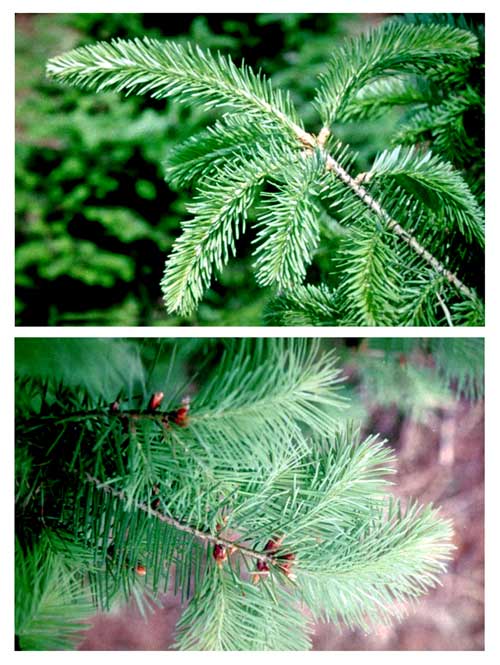The following are some of the most popular Christmas trees sold and grown in the United States:
– Balsam fir has short, flat, long-lasting needles that are rounded at the tip; nice, dark green color with silvery cast and fragrant. Named for the balsam or resin found in blisters on bark.
– Douglas fir holds blue to dark green; 1-inch to 1 1/2-inch needles; needles have one of the best aromas among Christmas trees when crushed. Named after David Douglas, who studied the tree in the 1800s; good conical shape; can live for 1,000 years.
– Fraser fir has dark green, flattened needles one-half- to 1-inch long; good needle retention; nice scent; pyramid-shaped strong branches which turn upward. Named for a botanist, John Fraser, who explored the southern Appalachians in the late 1700s.
– Noble fir has 1-inch-long, bluish-green needles with a silvery appearance; short, stiff branches; great for heavier ornaments; keeps well; is used to make wreaths, door swags and garland.
– Scotch pine is the most common Christmas tree; stiff branches; stiff, dark green needles 1 inch long; holds needles for four weeks; needles will stay on even when dry; has open appearance and more room for ornaments; keeps aroma throughout the season; introduced into the United States by European settlers.
– Virginia pine has dark green needles 1 1/2 to 3 inches long in twisted pairs; strong branches enable it to hold heavy ornaments; strong aromatic pine scent; a popular Southern Christmas tree.
– White pine has soft, blue-green needles, 2 to 5 inches long in bundles of five; retains needles throughout the holiday season; very full appearance; little or no fragrance; fewer allergic reactions compared with more fragrant trees. Largest pine in United States; state tree of Michigan and Maine; slender branches will support fewer and smaller decorations as compared with Scotch pine. American Indians used the inner bark as food. Early colonists used the inner bark to make cough medicine.

ONCE YOU BRING YOUR TREE HOME
A fresh-cut Christmas tree should last throughout the holiday season. Keep these tips in mind before heading out to the lot to purchase your Christmas tree:
– Know what size tree you want. Think about its placement in your home. Keep it away from sources of heat. Measure the area so you know what height and width you need. Bring a tape measure to the lot.
– Know the capacity of your tree stand and what size trunk will fit. A trunk too big or too small for the stand can tip the tree over. Trimming large branches near the base to make the tree fit in the stand could ruin the tree’s appearance.
– If you do not already have a stand, choose one that has enough water capacity for your tree. A tree can drink 1 quart of water per day for each inch of stem diameter. For example, a tree with a 4-inch stem diameter will use 1 gallon of water per day.
– Look for a tree that appears green and healthy with a fragrant smell. Green needles on fresh fir trees break crisply when bent sharply with the fingers. Pine needles, due to their fibrous natures, do not break if fresh. Some drop of older, interior needles is normal.
– Look for a lot that is well-lighted and stores trees in a shaded area.
– Signs of an excessively dry tree include faded color, musty smell, wrinkled bark on outer twigs and exterior needles that fall off with a gentle touch when the tree is bounced on a hard surface.
– Ask the vendor where the tree came from, how long ago it was cut and how often the lot receives shipments.
TREE MAINTENANCE
– Keep the tree in a cool and sheltered area out of the wind and sun until you are ready to decorate it.
– Before you set up your real tree, make a fresh cut across the base of the trunk about one-quarter-inch up from the original cut. Examine the trunk trimming to see how old your tree is.
– Place your tree in a stand that holds at least 1 gallon of water. In the first 24 hours, a fresh-cut Christmas tree will absorb more than a gallon of water. Make sure that your tree stand is never dry.
– If your tree stand goes dry, a seal of dried sap will form over the stump of the tree. This makes water intake impossible and another fresh cut will have to be made so the tree can drink again.
– Keep your tree away from heat and draft sources like fireplaces, stoves, radiators, and televisions that can dry out the tree. Be sure to unplug any lights on your tree before you go to bed or leave the house.
PROPER TREE DISPOSAL
The presents have been unwrapped, the lights have been unplugged and the ornaments have been packed away for another year. Now, how do you dispose of the tree?
Never burn it in the fireplace or wood stove, warns the National Christmas Tree associations. Instead, recycle it. According to the national association, recycled Christmas trees find new life as: chippings used in various projects from mulch to hiking trails, beachfront erosion prevention, lake and river shoreline stabilization, fish habitat, and river and delta sediment management.




